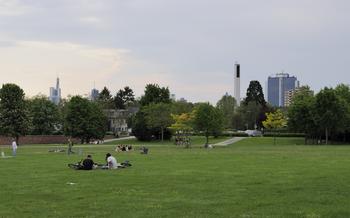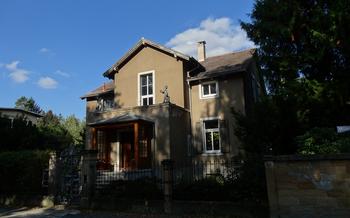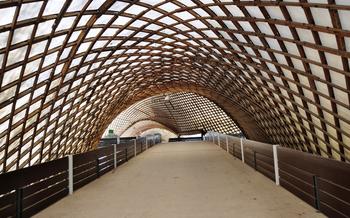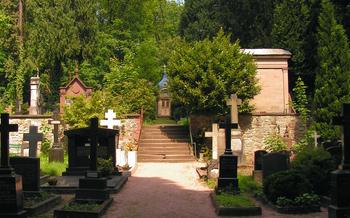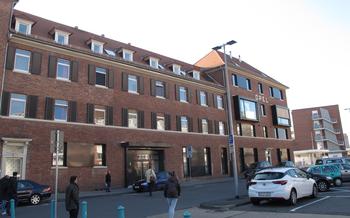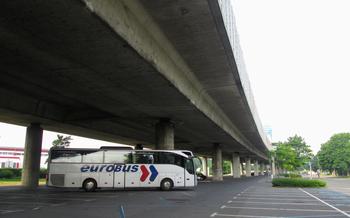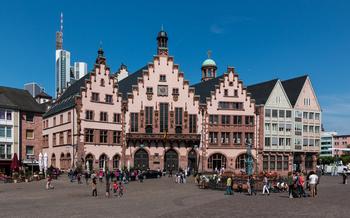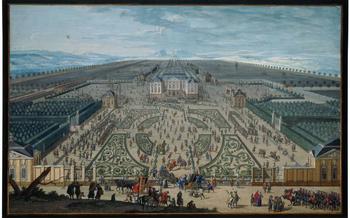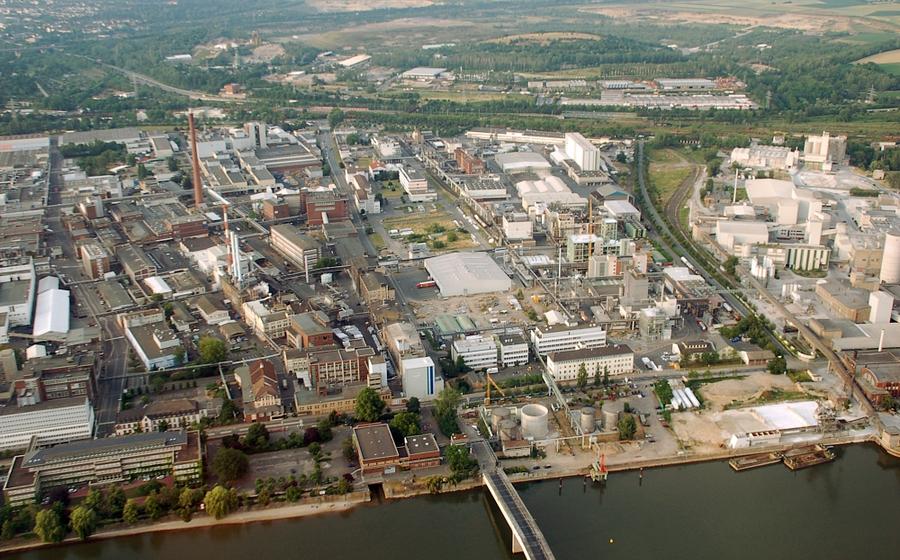
The Dyckerhoff Park
- Historical Background
- Unique Features
- Activities
- The Dyckerhoff Museum: A Journey Through Industrial History
- The Quarry Ponds
- The Playground
- Sculpture Exhibition
- Educational Programs
- Guided Tours
- Accessibility
- Tips for Visitors
- Insider Tip: Unveiling the Hidden Grotto
Historical Background
Dyckerhoff Park, nestled in the heart of Wiesbaden, Germany, boasts a rich and captivating history. Once an industrial site, the park underwent a remarkable transformation, evolving from a bustling cement factory to a verdant oasis for recreation and tranquility.
The park's industrial roots date back to the late 19th century when the Dyckerhoff cement factory was established. The factory played a significant role in the region's industrial development, producing high-quality cement used in the construction of numerous landmarks, including the Reichstag building in Berlin. However, as the city of Wiesbaden expanded, the factory's presence amidst residential areas became increasingly incompatible.
In the 1970s, the decision was made to relocate the cement factory to a more suitable industrial zone. This move paved the way for the transformation of the former factory site into a public green space. The city of Wiesbaden, recognizing the potential of the site, embarked on an ambitious project to create a park that would not only preserve the industrial heritage but also provide much-needed green space for the community.
The park's design was carefully crafted to honor its industrial past while embracing its new role as a place of leisure and natural beauty. The quarry ponds, remnants of the factory's extraction activities, were retained and integrated into the park's landscape, adding a unique and picturesque element. Former factory buildings were repurposed as cultural venues, housing a museum and event spaces. The result was a harmonious blend of industrial history and natural charm, creating a unique and captivating urban park.
Unique Features
Dyckerhoff Park is distinguished by its distinctive characteristics that set it apart from other green spaces. The park's most striking feature is its quarry ponds, which were once part of the Dyckerhoff cement factory's operations. Today, these ponds serve as a haven for wildlife, attracting a variety of birds and aquatic life. Visitors can explore the ponds via boat tours, offering a unique perspective of the park's natural beauty.
The park also boasts a diverse array of plant life, with over 1,000 species of trees, shrubs, and flowers. The Rose Garden is a particular highlight, featuring over 1,000 varieties of roses in a breathtaking display of color and fragrance. Additionally, the park is home to a Japanese Garden, offering a tranquil retreat with traditional elements such as a teahouse, a koi pond, and meticulously manicured landscapes.
Dyckerhoff Park is also dotted with historical structures, remnants of its industrial past. The Dyckerhoff Museum houses a collection of machinery and artifacts from the cement factory, providing insights into the park's rich history. Visitors can also admire the factory chimney, a towering landmark that stands as a testament to the park's industrial heritage.
Activities
The Dyckerhoff Park offers a wide range of activities for visitors to enjoy. The park's extensive network of trails makes it an ideal destination for walking and cycling enthusiasts. Visitors can choose from various routes that wind through the park's diverse landscapes, offering scenic views and opportunities for wildlife spotting. The park also features a boating lake, where visitors can rent rowboats or pedal boats to explore the tranquil waters. Anglers will be delighted to know that fishing is permitted in designated areas of the park, providing a chance to cast a line and enjoy the serene atmosphere. In addition to these activities, the park also offers a playground for children, ensuring that families with young ones have a fun and enjoyable visit. With its diverse range of activities, the Dyckerhoff Park caters to the interests of visitors of all ages, providing a perfect setting for a day of relaxation, recreation, and exploration.
The Dyckerhoff Museum: A Journey Through Industrial History
Step into the fascinating world of industrial heritage at the Dyckerhoff Museum, nestled within the verdant expanse of the Dyckerhoff Park. This remarkable museum houses a treasure trove of artifacts and exhibits that narrate the captivating story of the Dyckerhoff cement factory, which played a pivotal role in shaping the city's industrial landscape.
As you wander through the museum's halls, you'll be transported back in time to the early days of cement production. Pore over vintage machinery, tools, and documents that offer a glimpse into the intricate processes and techniques that were employed to create this essential building material. Learn about the innovative spirit and dedication of the Dyckerhoff family, whose vision and perseverance transformed Wiesbaden into a hub of cement manufacturing.
The museum's exhibits showcase a diverse collection of artifacts that tell the story of cement production from its humble beginnings to its modern-day applications. Discover the science behind cement's composition and its remarkable properties that have made it a cornerstone of construction and infrastructure development.
Through interactive displays and multimedia presentations, the museum brings to life the challenges and triumphs of the cement industry. Experience the hardships faced by the early pioneers and the ingenuity that led to groundbreaking advancements in cement technology.
A visit to the Dyckerhoff Museum is an enriching experience that offers a unique perspective on the industrial heritage of Wiesbaden. Whether you're a history buff, an architecture enthusiast, or simply curious about the world around you, this museum promises to captivate and inspire.
The Quarry Ponds
The Dyckerhoff Park is home to a series of picturesque quarry ponds, each with its own unique charm and significance. These ponds were formed as a result of the park's industrial past, when limestone was quarried from the site. After the quarrying operations ceased, the pits filled with water, creating a diverse aquatic ecosystem.
The largest of the quarry ponds is the Große Weiher, which offers visitors the opportunity to enjoy a leisurely boat ride or try their luck at fishing. The Kleine Weiher, on the other hand, is a popular spot for birdwatching, as it attracts a variety of waterfowl and other avian species.
The quarry ponds are not only aesthetically pleasing but also serve as important habitats for a variety of aquatic plants and animals. The clear waters provide a home for fish, amphibians, and reptiles, while the surrounding vegetation offers nesting and foraging sites for birds and insects.
In addition to their ecological value, the quarry ponds also offer recreational opportunities for visitors. Visitors can enjoy a leisurely walk or bike ride along the paths that wind around the ponds, or simply relax on the benches and soak up the tranquil atmosphere. The ponds also provide a unique backdrop for picnics, barbecues, and other outdoor gatherings.
The Playground
Dyckerhoff Park is a haven for children, with a dedicated playground that offers a range of facilities to keep them entertained and active. The playground is designed to cater to children of different ages and abilities, with a variety of equipment and play structures to suit their interests and needs.
The playground features traditional swings, slides, and climbing frames, as well as more adventurous options such as a zip line, a rope pyramid, and a sandpit for creative play. The soft rubber flooring ensures a safe and comfortable environment for children to play and explore.
The playground is also designed to be inclusive, with wheelchair-accessible ramps and play equipment that allows children with disabilities to participate in the fun.
Sculpture Exhibition
Dyckerhoff Park is home to a notable collection of sculptures, each adding a unique artistic touch to the landscape. These sculptures are the result of collaborations between the park and various artists, both local and international, who have been inspired by the park's natural beauty and industrial heritage.
As visitors stroll through the park, they will encounter a diverse array of sculptures, from abstract and modern pieces to more traditional and figurative works. Some sculptures are placed prominently along the main paths, while others are tucked away in hidden corners, inviting visitors to explore and discover them.
One of the most striking sculptures is "The Quarryman" by German artist Bernd Ehinger. This bronze sculpture depicts a muscular worker emerging from the earth, symbolizing the park's industrial past and the labor that went into creating the quarry ponds.
Another highlight is "The Dancing Cranes" by Japanese artist Masayuki Nagare. This elegant sculpture features two cranes in motion, capturing the grace and beauty of these majestic birds in flight.
The sculpture exhibition at Dyckerhoff Park offers a unique opportunity to appreciate art in a natural setting. Visitors can take a leisurely walk through the park, enjoying the sculptures along the way, and gain a deeper appreciation for the interplay between nature and art.
Educational Programs
The Dyckerhoff Park offers a variety of educational programs and workshops throughout the year, catering to visitors of all ages. These programs are designed to promote environmental awareness, encourage hands-on learning, and foster a deeper understanding of the park's unique features.
One popular program is the "Nature Discovery Tour," which takes participants on a guided exploration of the park's diverse plant and animal life. Led by experienced naturalists, the tour provides insights into the park's ecology, conservation efforts, and the importance of preserving its natural heritage.
For children, the park offers interactive workshops and activities focused on environmental education. These workshops may include topics such as seed planting, birdwatching, or creating nature crafts. Through these hands-on experiences, children learn about the natural world while developing a sense of responsibility for the environment.
The park also collaborates with local schools to offer educational field trips, providing students with an immersive learning experience outside the classroom. These field trips can be tailored to specific curriculum needs, allowing students to explore topics such as geology, botany, and history in a real-world setting.
By participating in these educational programs, visitors of all ages can gain a deeper appreciation for the Dyckerhoff Park's natural and cultural heritage while fostering a sense of environmental stewardship.
Guided Tours
For visitors seeking a deeper understanding of the park's history, nature, and attractions, guided tours are an excellent option. Knowledgeable and passionate guides lead these tours, providing insights into the park's industrial past, the diverse flora and fauna, and the significance of the various historical structures.
Guided tours typically cover the park's main highlights, including the quarry ponds, the rose garden, the Dyckerhoff Museum, and the Japanese garden. Guides share fascinating stories and anecdotes, bringing the park's past to life and highlighting its ecological and cultural importance.
Visitors can choose from a variety of guided tours, each tailored to specific interests and preferences. There are general tours that provide a comprehensive overview of the park, as well as themed tours that focus on particular aspects, such as the park's geology, botany, or history.
To ensure a spot on a guided tour, it's advisable to book in advance, especially during peak tourist season. Reservations can be made through the park's website or by contacting the visitor center.
Whether you're a history buff, a nature enthusiast, or simply someone looking to learn more about this unique park, a guided tour is a rewarding experience that will enhance your visit to the Dyckerhoff Park.
Accessibility
The Dyckerhoff Park is committed to ensuring that everyone can enjoy its beautiful spaces and attractions. The park features wheelchair-friendly paths and ramps, allowing visitors with limited mobility to navigate the grounds comfortably. Designated parking areas for disabled visitors are also available near the park's entrances, providing convenient access. With these accessibility features in place, the park welcomes visitors of all abilities to immerse themselves in its natural and cultural wonders.
Tips for Visitors
To make the most of your visit to the Dyckerhoff Park, here are some practical tips to consider:
Plan Your Route: With over 100 hectares to explore, it's helpful to plan your route before you arrive. The park provides maps and guides at the visitor center, or you can download them online.
Choose the Right Time: The park's beauty and atmosphere change throughout the year. Spring is ideal for witnessing the vibrant colors of the rose garden, while autumn offers breathtaking views of the changing foliage.
Explore Nearby Attractions: The Dyckerhoff Park is situated in a charming area of Wiesbaden. Take advantage of your visit to explore nearby attractions such as the Nerobergbahn funicular, the Wiesbaden Kurhaus, and the Thermal Baths.
Pack a Picnic: The park offers several idyllic spots for picnics. Bring along a blanket, snacks, and drinks to enjoy a leisurely meal amidst the tranquil surroundings.
Wear Comfortable Shoes: The park's extensive network of paths and trails is perfect for walking and cycling. Wear comfortable shoes to make the most of your exploration.
Bring Your Camera: The park's picturesque landscapes, stunning gardens, and unique structures provide ample opportunities for photography. Capture the beauty of your visit with your camera or smartphone.
Insider Tip: Unveiling the Hidden Grotto
Venture beyond the manicured gardens and tranquil ponds to discover a hidden gem nestled within the Dyckerhoff Park – the Grotto. This enchanting cave-like structure, tucked away amidst lush greenery, offers a secluded retreat from the bustling city. Step inside to be greeted by cool, damp air and the gentle sound of dripping water. Admire the intricate rock formations that adorn the walls, each telling a story of the park's geological past. The Grotto provides a unique and intimate setting for contemplation, relaxation, and a sense of connection with nature. Whether you seek solitude or simply a quiet spot to appreciate the park's natural beauty, the Grotto awaits your exploration.
